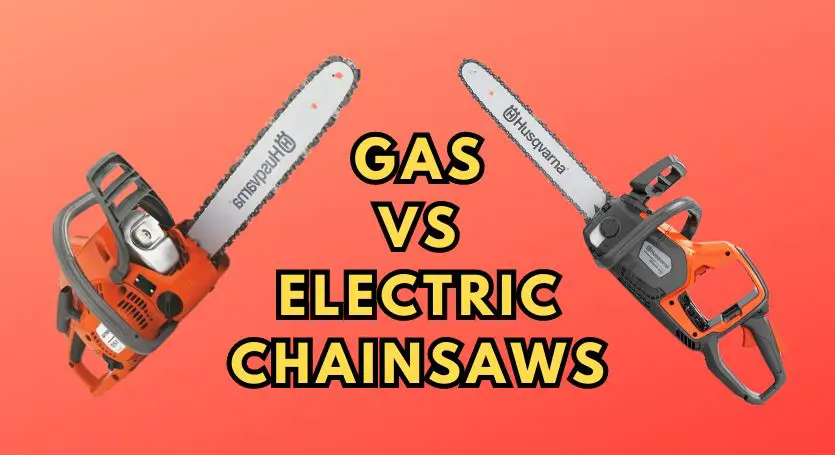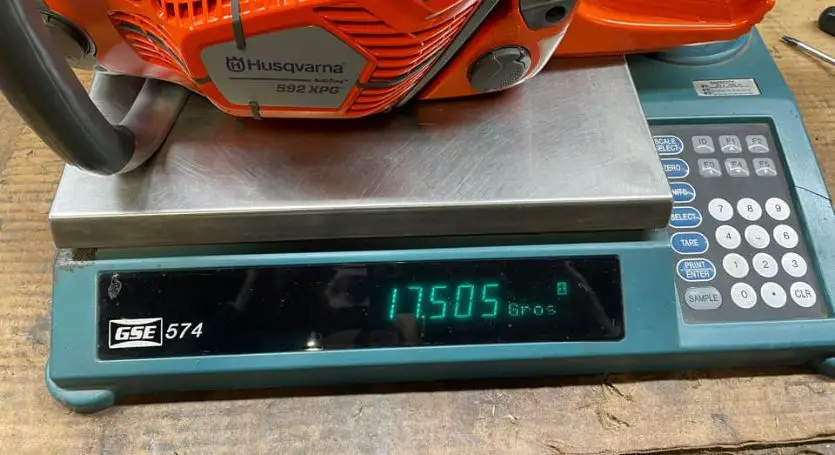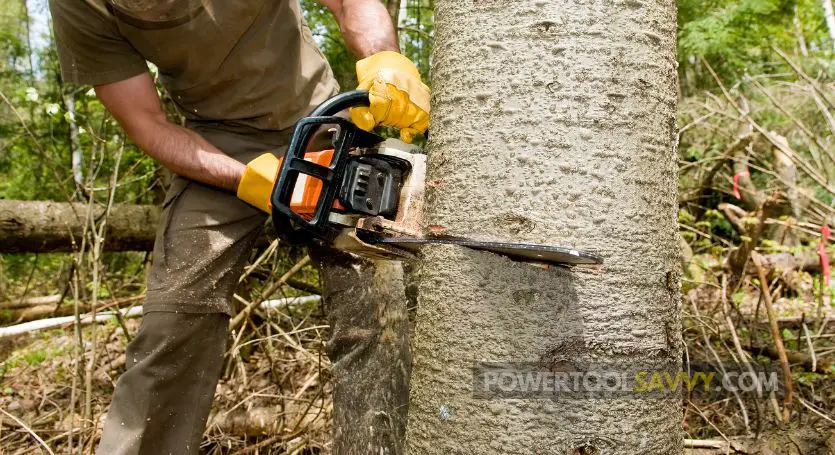
Gas or electric chainsaw? Which one should you choose?
Gas chainsaws are more powerful, noisier, heavier, cheaper, more expensive to maintain, and offer a longer run time. On the other hand, electric chainsaws are less powerful, lighter, quieter, more expensive to purchase, cheaper to maintain, and have a limited run time.
In this article, I’m going to discuss all the differences between gas and electric chainsaws and help you determine which one is better for your needs.
Are you ready?
Let’s get started!
Table of Contents
ToggleGas Vs Electric Chainsaw Comparison
Now, let’s have a look at how gas and electric chainsaws compare in different areas.
Power
When it comes to power, gas-powered chainsaws are the clear WINNER!
They can produce almost twice the power of an electric chainsaw. This makes them ideal for all kinds of heavy-duty tasks like cutting large trees or thick logs.

Starting from 20cc to around 120cc, gas chainsaws come in a variety of sizes to cater to the needs of homeowners and professionals alike.
Electric chainsaws may lack the RAW power, but they’ve improved significantly in performance over the years.
They are well-suited for light to moderate tasks, such as pruning, limb cutting, and small to medium-sized tree felling.
Maintenance & Care
“With great power comes great responsibility” – this saying holds true for gas chainsaws.
Gas engines require regular oil changes, air filter replacements, spark plug checks, and carburetor adjustments. Also, the fuel tank needs to be refilled periodically.
Yeah, a lot of work, I know!
But electric chainsaws require way less maintenance. Charge the battery or plug it in and you’re good to go!
No fuel mixes, no spark plugs, no air filters – just simple care of the chain and guide bar.
Weight

Again electric chainsaws take the lead when it comes to weight!
They are designed to be lightweight. They typically weigh between 8 to 12 lbs, with smaller and more compact models on the lower end of the scale.
On the other hand, gas chainsaws tend to be heavier, ranging from 10 to 20 lbs or more, depending on the engine size and features.
This makes electric chainsaws easier to handle and enhances the saw’s maneuverability, allowing users to navigate tight spaces and make precise cuts more easily.
Run Time
In terms of run time, gas chainsaws are totally unbeatable. As long as there’s fuel, the saw will keep running.
However since most electric chainsaws rely on batteries, they have a limited run time.
The average battery-powered model can last anywhere from 20 minutes to 60 minutes (max) per charge. Plus there’s also the hassle of charging or replacing batteries.
For corded models, the run time may not be an issue, but the length of the cord limits portability and restricts movement.
Environmental & Noise Concerns
Gas chainsaws emit exhaust fumes, contributing to air pollution. Plus the need for fuel adds to the carbon footprint.
But electric chainsaws produce ZERO emissions at the point of use. The environmental impact depends on the electricity source; if sourced from renewable energy, electric saws can be eco-friendly.
Also speaking of noise, gas chainsaws can be incredibly loud due to their combustion engine.
On average, they can produce noise levels of 120 decibels or more, which can be damaging to your hearing. (Read this article to learn about protecting your ears while using chainsaws)
Electric chainsaws are comparatively much quieter, with an average noise level between 80 to 100 decibels. This makes them a better choice for residential areas and neighborhoods.
Ease of Use

Gas chainsaws have a steeper learning curve due to their complex mechanisms.
You at least need to have a basic understanding of different parts and how to mix fuel, operate the choke, and start the saw safely.
Also, there are a ton of engine-related troubleshooting that can arise in gas models.
Electric chainsaws are beginner-friendly. They have fewer moving parts, and the starting process is simple (just press a button or pull a trigger).
Plus they run cleaner and cause less vibration, making them easier to handle for anyone.
Price
Last but not least – the price!
Electric chainsaws are more expensive than gas-powered ones. Depending on the model, an electric chainsaw could cost up to twice the price of a gas model with similar power.
But can I be totally honest with you?
If you take after-sales maintenance and fuel costs into consideration, gas chainsaws actually cost more in the long run.
So, it’s all about choosing the right chainsaw to fit your specific needs and budget.
Bar Length Compatibility
On a gas chainsaw, you can put a bar as long as you want (depending on its power), which is not the case on an electric chainsaw.
The reason for this is because electric motors don’t have enough power to drive a longer bar.
Here’s a chart that lists the recommended bar length for both gas and electric chainsaws based on their power:
| Chainsaw Type | Power Rating | Recommended Bar Length |
|---|---|---|
| Gas-powered | Less than 25 cc | 10-12” |
| Gas-powered | 26-35 cc | 12-16” |
| Gas-powered | 36-45 cc | 14-20” |
| Gas-powered | 46-60 cc | 16-24” |
| Gas-powered | 60-75 cc | 18-28” |
| Gas-powered | 76-90 cc | 20-32” |
| Gas-powered | 91-100 cc | 24-36” |
| Gas-powered | 100-115 cc | 26-50” |
| Gas-powered | More than 116 cc | 28-84” |
| Battery-powered | 18-20 Volts | 10-12" |
| Battery-powered | 24-30 Volts | 10-14" |
| Battery-powered | 36-40 Volts | 10-16" |
| Battery-powered | 40-50 Volts | 12-18" |
| Battery-powered | 50-60 Volts | 12-20" |
| Corded Electric | 8-12 Amps | 10-16" |
| Corded Electric | 13-15 Amps | 12-18" |
As you can see, electric chainsaws have a maximum recommended bar length of around 18 inches, whereas a homeowner-level gas chainsaw can handle a bar of up to 24 inches.
So in terms of bar length compatibility, gas-powered chainsaws have an advantage over electric ones.
Final Thought: Which One Is Better?
That concludes our in-depth comparison of gas and electric chainsaws.
So, which one is better?
Well, it all boils down to what your priorities are and how you’re going to use the chainsaw. Because at the end of the day, both types of saws have their pros and cons.
For example:
If you’re a professional or an avid DIYer who needs maximum power and portability and is willing to put in some extra maintenance work, a gas-powered chainsaw would be your best bet.
But if you’re a casual homeowner who wants something lightweight, low-maintenance, and less noisy, an electric chainsaw may be a better choice.
Happy sawing!





